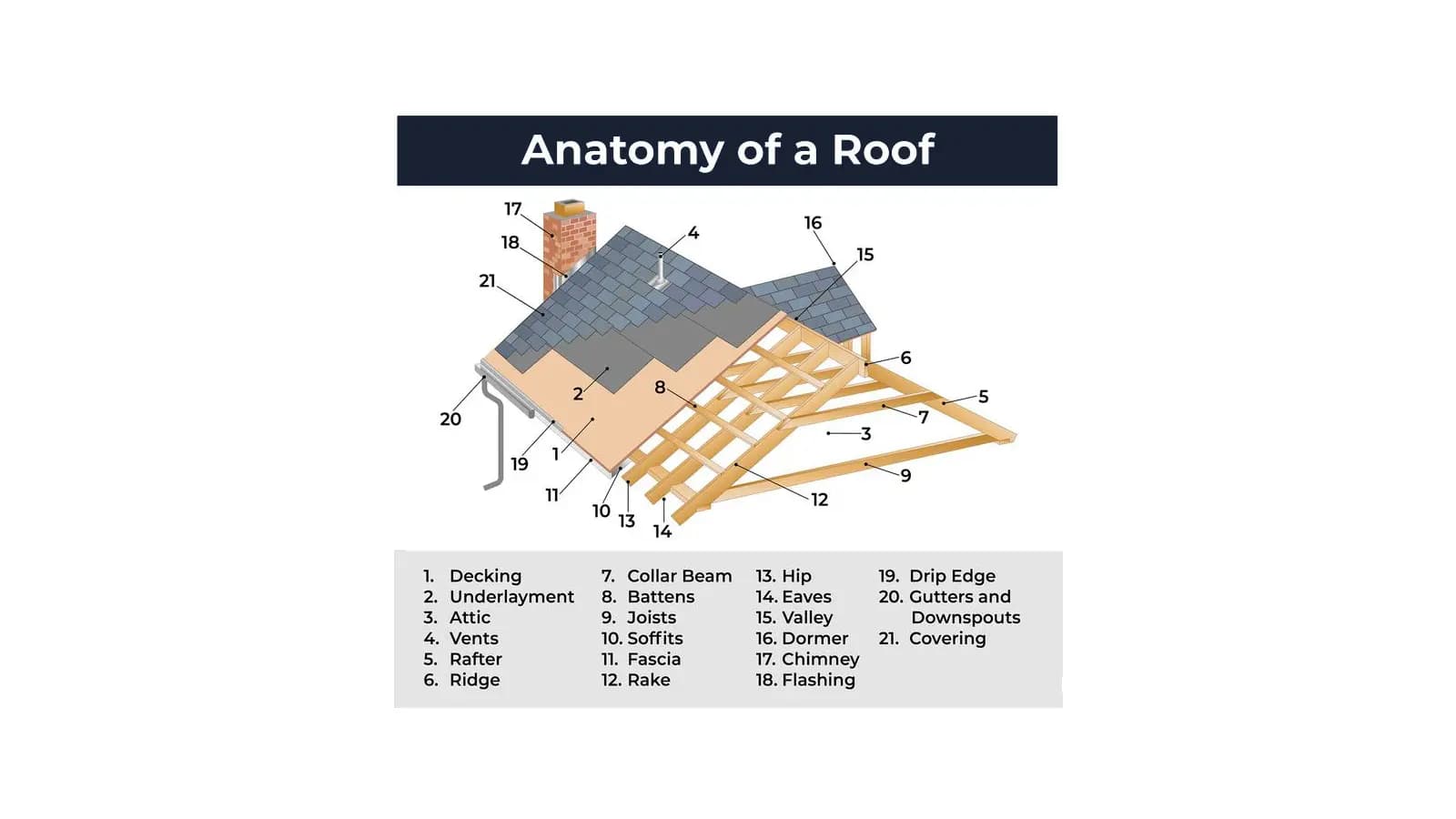More Than Just Shingles
Most homeowners look at a roof and see shingles — maybe vents or gutters. But beneath that surface lies a carefully engineered system designed to shield your home from wind, rain, heat, and cold. Knowing the anatomy of your roof helps you spot problems early, understand estimates, and make informed choices during repairs or replacements.
1. Decking
Also called roof sheathing, decking is the structural foundation of your roof. It’s usually made of plywood or oriented strand board (OSB) and fastened directly to the rafters. Everything else — underlayment, shingles, flashing — attaches to this surface. Rotten or warped decking must be replaced to ensure a solid base for your roof.
2. Underlayment
This thin layer sits between the decking and shingles. It acts as a secondary moisture barrier, protecting against wind-driven rain and leaks. Synthetic underlayment has largely replaced old asphalt felt, offering better durability and water resistance.
3. Attic
The attic isn’t technically part of the roof, but it plays a critical role. Proper ventilation and insulation in your attic help control temperature and humidity, preventing ice dams in winter and excess heat in summer that can shorten shingle life.
4. Vents
Roof vents allow air to circulate through the attic, balancing intake and exhaust. Without them, heat and moisture build up, leading to mold, warped decking, and premature roof aging. Common types include ridge vents, box vents, and soffit vents.
5. Rafters
Rafters are the angled beams that form the skeleton of your roof. They support the weight of the decking and shingles. In modern homes, they’re often replaced by trusses — prefabricated triangular frames that offer even strength and easier installation.
6. Ridge
The ridge is the highest horizontal line on your roof, where two sloping sides meet. It’s usually covered by ridge cap shingles or venting systems that let warm air escape. If improperly sealed, the ridge can be a prime location for leaks.
7. Collar Beam
A collar beam connects opposing rafters near the ridge. It adds stability and helps resist wind uplift — especially important during severe Tennessee storms.
8. Battens
Battens are thin strips of wood or metal installed horizontally across rafters. They’re more common in metal roofing or tile systems, providing attachment points and improving airflow beneath the covering.
9. Joists
Joists form the horizontal framework beneath the roof structure, tying the walls together. They also support the attic floor. When joists sag or crack, it can indicate structural stress or excessive roof weight.
10. Soffits
Soffits are the underside panels of your roof’s overhang. They contain ventilation openings that draw cool air into the attic. Keeping soffit vents clear of insulation and debris is vital for balanced airflow.
11. Fascia
The fascia board runs along the lower edge of your roof, connecting to the ends of the rafters. It supports gutters and creates a clean finished edge. Because it’s exposed, fascia is prone to rot if gutters overflow or back up.
12. Rake
The rake is the sloped edge of a gable roof. It extends from the eaves to the ridge and helps direct water away from the siding. A drip edge or rake trim prevents moisture infiltration along this line.
13–16. Hips, Eaves, Valleys, and Dormers
- Hip: The angle formed where two roof planes meet outwardly.
- Eaves: The lower edge that overhangs the walls, protecting siding from rain.
- Valley: The inward intersection of two roof planes — a natural water channel that must be sealed perfectly.
- Dormer: A small projection containing a window, adding natural light and ventilation. Dormers are common in traditional and craftsman-style homes.
17–21. Chimney, Flashing, Drip Edge, Gutters, and Covering
- Chimney: Requires precise flashing to prevent leaks at its base.
- Flashing: Thin metal strips sealing joints and penetrations — around chimneys, skylights, or vents.
- Drip Edge: A metal flange that directs water into the gutters instead of under the shingles.
- Gutters and Downspouts: Direct water safely away from your home’s foundation.
- Covering: The visible layer — asphalt shingles, metal, tile, or slate — that provides your roof’s first line of defense.
The Bottom Line
Every piece of your roof works together as one system. If even one part fails — a blocked vent, missing flashing, or cracked decking — the whole structure is at risk. By understanding this anatomy, you can better maintain your home and speak confidently when hiring a roofer.
Want a Professional Roof Evaluation?
👉 Schedule Your Free Inspection Today
📞 Call (931) 221-2115 — our experts at Hoots Roofing will walk you through your roof’s anatomy, show photos of its current condition, and explain exactly what it needs.

